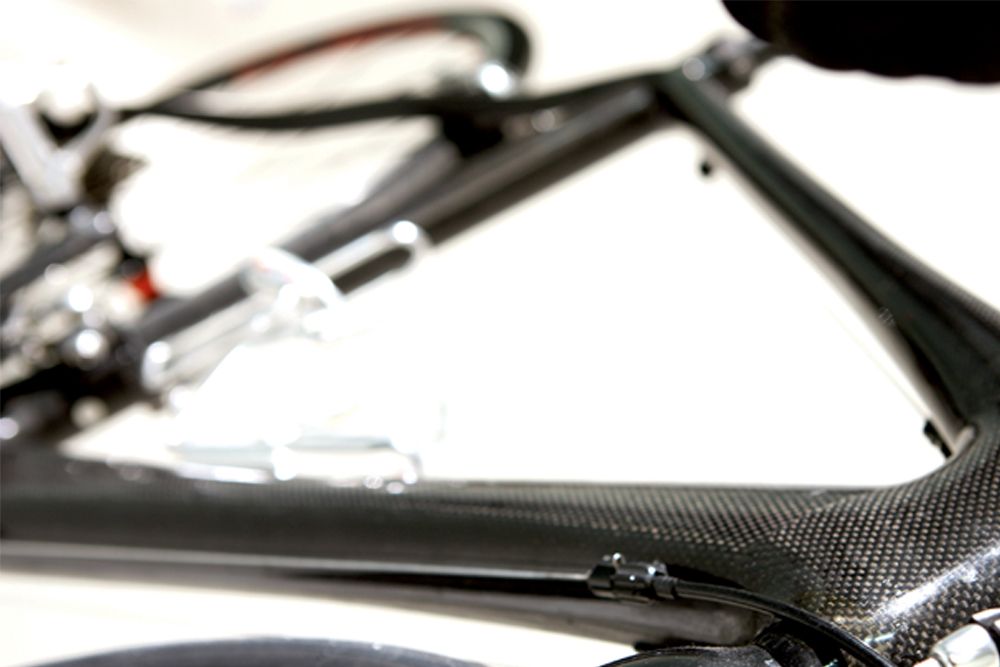Do carbon frames have a shelf life?
Should you be worried about your carbon frame wearing out?


A carbon bike frame is a matrix of two different materials: the carbon fibres which give the frame its structural strength, and the resin which binds the carbon together.
They each have different properties, both physically and chemically, which determine the frame’s structural integrity.
There are a host of factors which could influence a frame’s lifespan, starting with the simple act of riding it. Carbon frames are well able to withstand the day-to-day flexion required to negotiate bumpy roads.
But a more major shock such as a crash needs specialist examination, while over-tightening bolts can also lead to damage.
>>> Carbon beware: are aluminium frames making a comeback?
Internal damage to frame tubes may not immediately be evident and carbon repairers will use specialist techniques such as ultrasound and X-rays to identify deeper damage.
The carbon fibres used are very strong, but the resin needed to hold them together is potentially susceptible to degradation over time.
Thomas Leschik, chief technology officer at Lightweight highlights this degradation as a factor which will alter the frame’s properties.
>>> How to get into road cycling for less than £500
Resins used in carbon-fibre composites are heat-sensitive and manufacturers recommend that bikes are not kept in hot environments such as inside cars.
But again this is not likely to be an issue except in extreme cases: curing of carbon frames takes place at well over 100°C and it’s unlikely that this temperature would be reached once the frame leaves the factory.
>>> The best cheap bikes: ridden and rated
UV radiation is another potential cause of degradation of the resin. But carbon frames are routinely painted with UV-resistant lacquers and paints and modern resins are designed to have intrinsic UV and temperature resistance too.
Prolonged exposure to intense sunlight might lower the lifetime of your frame. “Somebody riding every day in the desert and having 12 hours’ full sun exposure and extreme heat would have a different effect than an average rider,” says Thomas Trapp, head of engineering at Focus Bikes.
For UK riders such conditions are a pipe dream.
More of the big questions in cycling technology
Cheap Chinese carbon imports: are they worth the risk?
Should the UCI weight limit be scrapped?
Do we need 12-speed groupsets?
Salt water a concern
Of more significance to UK riders is the effect of riding on wet roads, particularly in the winter when road spray could contain salt from road gritting. Sweat dripping onto the frame when riding on a turbo can also be a problem.
Although salt is not damaging to carbon composites, where the carbon-fibre meets metal parts, salt water acts as an electrolyte, setting up an electric cell between the carbon and the metal which can, over time, oxidise and erode the metal.
It’s a particular issue with forks with carbon blades and aluminium steerers. Upgrade Bikes has recently recalled a number of its older Racelight forks for this very reason.
Damian Mason, head of Upgrade, says that they have seen forks in very poor condition, where the protective coating of paint over the fork to steerer junction has been damaged and galvanic corrosion has degraded the steerer tube.
Of course, the same problem can occur with any metal components attached to a carbon frame, such as bottom bracket bearings. But since these are not structural, the potential for catastrophic failure is less — it’s more likely to end in a bill to replace an expensive component than a complete failure.
Thomas Trapp says that Focus incorporates a layer of glass-fibre in critical areas of its frames to act as a barrier against such galvanic effects.
Thinking about getting discs?
Our take
Treat a modern carbon frame well and there should be limited potential for degradation over a bike’s working life. But any damage, including to the paintwork, needs to be looked at.
No frame exists without metal parts attached to it and many bikes have forks with alloy steerer tubes. Unless metal to carbon-fibre connections are fully sealed and kept scrupulously clean and dry, there’s a risk of galvanic corrosion setting in, particularly on wet, salted winter roads or when using a turbo.
Yes: Damian Mason, Upgrade Bikes
Although a modern carbon frame is a monococoque structure and is therefore very strong, the problem lies in the joints, particularly to metals.
It’s really important to keep your bike clean and have it checked out if there are signs of corrosion or damage such as bubbly finish — and especially cracks.
No: Thomas Trapp, head of engineering, Focus Bikes
Carbon composite based on epoxy resin shows a very long lifetime during fatigue testing, thus there’s no degradation of the composite over the lifetime of a bike.
Only long-term strong UV exposition can harm the epoxy structure, but all our frames have a UV protective agent included in the final paint layer.

Thank you for reading 20 articles this month* Join now for unlimited access
Enjoy your first month for just £1 / $1 / €1
*Read 5 free articles per month without a subscription

Join now for unlimited access
Try first month for just £1 / $1 / €1
Get The Leadout Newsletter
The latest race content, interviews, features, reviews and expert buying guides, direct to your inbox!
Paul started writing for Cycling Weekly in 2015, covering cycling tech, new bikes and product testing. Since then, he’s reviewed hundreds of bikes and thousands of other pieces of cycling equipment for the magazine and the Cycling Weekly website.
He’s been cycling for a lot longer than that though and his travels by bike have taken him all around Europe and to California. He’s been riding gravel since before gravel bikes existed too, riding a cyclocross bike through the Chilterns and along the South Downs.
-
One domestic road race can produce equivalent emissions to flying from London to New York and back, twice: the why and how of more sustainable events
Sustainability specialist and road race organiser Travis Bramley set out to discover if his love for cycling could align with his commitment to the environment. Here’s what he found
By Travis Bramley Published
-
 Is Mathieu van der Poel winning races “in zone 2” helping or hindering cyclo-cross?
Is Mathieu van der Poel winning races “in zone 2” helping or hindering cyclo-cross?The Dutch world champion has turned up off-road now, and immediately won twice. Is this fun?
By Adam Becket Published
-
Are airless bike tires the answer for reliable commuting?
With no risk of punctures to stop you, will airless bike tires make your cycling commute more dependable?
By Paul Norman Published
-
Should you cycle with earphones in?
Listening to music while riding is controversial but the evidence regarding safety cuts both ways and a favourite tune can boost performance
By Cycling Weekly Published
-
Should the UCI relax its bike rules?
Simon Smythe reflects on the regulatory inertia that some say is stifling innovation in bike design
By Simon Smythe Published
-
Hands together or hands apart: what’s faster?
Optimising aerodynamics is a trade-off between perfection and real-world versatility
By Simon Smythe Published
-
Aero road helmets: can they make you faster?
Aero road helmet: The latest wind-cheating lids are a common sight in the pro peloton - but does the everyday rider need one?
By Michelle Arthurs-Brennan Published
-
At what point does aero become more significant than weight?
We find out which buying consideration is of most relevance to the everyday cyclist
By Oliver Bridgewood Published
-
Do you need an aerosuit for road riding?
Should we all be wearing the tightest of tight cycle clothing, an aerosuit?
By James Bracey Published
-
Is road bike suspension just a gimmick?
We investigate suspension in road frames and ask is it worth the investment?
By James Bracey Published








